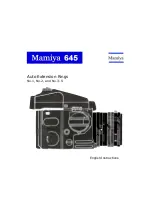
Manual, F/T Sensor, Ethernet Axia
Document #9620-05-C-Ethernet Axia-02
Pinnacle Park • 1031 Goodworth Drive • Apex, NC 27539 • Tel:+1 919.772.0115 • Fax:+1 919.772.8259 •
C-81
12.
UDP Interface Using RDT
The Ethernet Axia can output data at up to 7912 Hz over Ethernet using UDP. This method of fast data collection
is called Raw Data Transfer (RDT). RDT provides the following data in a packet: forces, torques, and status codes
of the Ethernet Axia. Example of RDT (UDP) commands are in the following sections but can also be found on the
Interface Example
Section 6.10—Interface Example Page (examples.htm)
NOTICE:
Multi-byte values must be transferred to the network high byte first and with the correct
number of bytes. Some compilers align structures to large field sizes, such as 32- or 64-bit fields,
and send an incorrect number of bytes. C compilers usually provide the functions
htons(), htonl(),
ntohs(),
and
ntohl()
that can automatically handle byte ordering issues and provide alignment directives
that force structures to place fields directly next to each other in memory. Consult the compiler’s
documentation for information on structure alignment.
12.1 RDT Protocol
The Ethernet Axia listens on the selected UDP port for commands. The sensor responds to the IP address and
port that sent the command. The default UDP port is 49152. A user can also change the UDP port through
the sensor’s Communication page (
Section 6.7—Communication Page (comm.htm)
).
In the RDT protocol, there are (4) commands that are listed in following table. A command received by the
Ethernet Axia sensor takes precedence over previously-received commands.
Table 12.1—RDT Commands
Command
Code
Purpose
Command
Response
Stop
0x0000
Stop sending RDT packets over UDP.
None.
Start
single-
block
0x0001
Start sending RDT packets over UDP to the requestor,
single blocks only, regardless of the RDT buffer size
setting. Use the Count field to send a specific number of
packets, 0 = unlimited.
RDT
record(s).
0x0002
Start multi-
block
0x0003
Start sending RDT packets over UDP to the requestor,
how many RDT packets are blocked depends on the RDT
buffer size setting. Use the Count field to send a specific
number of packets, 0 = unlimited.
RDT
record(s).
Bias
0x0042
Set Software Bias.
None.
The sensor generates a record in a format that is specified by the RDT Output Rate“rdtRate”. The sensor
groups one or more of these records into a single UDP packet. The size of the packet depends on the value
of the RDT buffer size or “rdtSize”. If using buffered mode, then the number of RDT records received in a
UDP packet will be equal to the RDT buffer size displayed on the Communications page. For a description
of RDT Buffer Size, refer to
Section 6.7—Communication Page (comm.htm)
. Command and reply formats
are explained in the following sections.















































